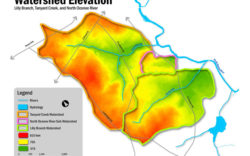Tom Crawford’s July 8 column (“Conserve Water or We’ll Wind Up Drinking from the Toilet”) paints a dire picture of the future of our drinking water, despite clear trends that Georgians have been using less and less water over the past 30 years or so. What else can you do to conserve water? The best way to figure out where you have the most potential to improve is to conduct a simple water audit. Start with your monthly water bill, looking at the number under the “usage” column. Athens-Clarke County lists usage in thousands of gallons, so if it says “1.0,” it means you used 1,000 gallons that month.
Knowing the total monthly usage isn’t terribly interesting or useful, but it’s only the first step; now it’s time to figure out where all that water goes. It may be easier to think in terms of a week instead of a month, so let’s say for the sake of simplicity that you used an average of 250 gallons per week (i.e. 1,000 divided by four). Now, list all the ways you use water at home: shower, bath, bathroom sink, toilet, kitchen sink, dishwasher and clothes washer.
Most shower heads have a flow rate of 2.5 gallons per minute. Bath volumes vary, but 30 gallons is a good estimate. Any toilet made after 1992 uses 1.6 gallons per flush. Typical bathroom and kitchen faucets use 2.2 gpm. An Energy Star dishwasher uses at most 4.3 gallons per cycle, the best in class uses 2.2, and a run-of-the-mill dishwasher uses five. Energy Star front-load clothes washers use about 13 gallons per cycle, while regular top-loaders use 23.
Now’s the part where you think to yourself, “Math? In Flagpole?” Don’t worry, this is easy. If you know the gallons per minute or per use, and you can estimate how many minutes or cycles are used in a week, you can start to see how that 250 gallons breaks down.
Let’s say you take five-minute showers every day: five minutes per day times 2.2 gpm equals 11 gallons per day, or 77 per week. If you do two loads of laundry per week with a top-load washer, two cycles times 23 gallons equals 46 gallons. Seventy-seven plus 46 equals 123, which means about half of your water use is showers and laundry. Keep going with the other uses (toilets, dishes, etc.), tweaking your estimates until they add up to your 250 gallon total.
So now you have a fancy pie chart. (You made a pie chart, right?) There are two ways to look at the results. First, what were your biggest categories? Is there something you can do to cut back? Second, are there cheap and simple things you can change to reduce usage in any of the categories? Shorter showers and turning the tap off while you brush are obvious, but here are a couple of examples that you may not have thought of.
If you prefer not to follow the “if it’s yellow, let it mellow” policy and can’t install a dual flush toilet, you can often fake it by finessing the handle or tweaking the flapper valve. On some toilets, you can achieve a partial flush by gently pressing the flush handle part way. In other cases, if you look in the tank, you’ll see a small chain that connects the handle to the rubber flapper. Experiment with the length of the chain to adjust the flush volume depending on how long you hold the handle down, and just like that, you have a free dual-flush toilet.
If you have a dishwasher, you’d have to wash a full load by hand, running the faucet for a total of two minutes, to beat even an old machine with a five-gallon cycle. If you don’t have a dishwasher, for $5 you can easily install a kitchen faucet aerator with a pause valve so you can shut the water off with a flick of the finger without losing your temperature setting. If you use it while you wash up by hand, you’ll quickly see a return on your investment both in water and energy savings.
Got a question for the Greensplainer? Email [email protected].
Like what you just read? Support Flagpole by making a donation today. Every dollar you give helps fund our ongoing mission to provide Athens with quality, independent journalism.










